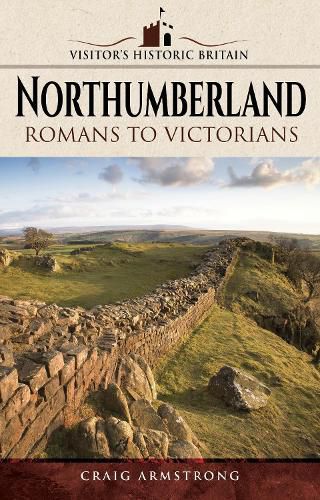Readings Newsletter
Become a Readings Member to make your shopping experience even easier.
Sign in or sign up for free!
You’re not far away from qualifying for FREE standard shipping within Australia
You’ve qualified for FREE standard shipping within Australia
The cart is loading…






Northumberland to the Romans it was Ad Fines, the limit of the Empire, the end of the Roman World. It was here in 122 AD that the Emperor Hadrian decided to build a wall stretching from coast-to-coast to provide protection, to show the might of the Empire, and as a statement of his grandeur. Visitors to Northumberland can walk the Wall visiting milecastles, Roman frontier forts and settlements such as Housesteads (where you can see the oldest toilets you ll ever see) or Vindolanda (where you can take part in an archaeological dig) where wooden tablets detailing life on this frontier (the oldest example of written language in Britain) were discovered, or the remains of Roman temples and shrines (such as the Mithraeum at Carrawburgh). After the Romans left, Northumberland became the heart of one of the greatest kingdoms of Anglo-Saxon Britain, Northumbria. The home of Saints, scholars and warrior kings. Visitors can see the ancient seat of this kingdom at the medieval Bamburgh Castle, visit Hexham Abbey (built in 674 AD), or tour the magnificent remains of the 7th century Priory at Tynemouth (where three kings are buried Oswin (d. 651), Osred (d. 790), and the Scottish King Malcolm III (d. 1093). No other county in Britain has as many medieval remains as Northumberland. From the most grand such as Alnwick Castle (known as the Windsor of the North, the home of the Dukes of Northumberland, the capital of Northumberland, and, to many, Hogwarts!) to humble remains such as the Chantry at Morpeth. At Warkworth visitors can tour the medieval church (scene of a 12th century Scottish massacre), Warkworth Castle (another Percy possession and the setting for a scene in Shakespeare s Henry IV), a medieval hermitage, and the fortified bridge gatehouse (one of the only surviving examples in Britain). Northumberland was ravaged during the Anglo-Scottish Wars and this led to the development of family clans of Border Reivers who were active during the 16th and early 17th centuries. Raiders, looters, blackmailers and courageous cavalrymen the Reivers have left many surviving remnants of their harsh time.
AUTHOR: Born and bred in Northumberland, Dr Craig Armstrong is an experienced historian, with a special interest in the history of the North East of England and Scotland. He has expertise in nineteenth and twentieth-century history, with a particular focus on social and military history. Dr Armstrong currently splits his time between working as a freelance author and researcher on all things North Eastern and Scottish and teaching part-time at Newcastle University. 30 illustrations and maps
$9.00 standard shipping within Australia
FREE standard shipping within Australia for orders over $100.00
Express & International shipping calculated at checkout
Northumberland to the Romans it was Ad Fines, the limit of the Empire, the end of the Roman World. It was here in 122 AD that the Emperor Hadrian decided to build a wall stretching from coast-to-coast to provide protection, to show the might of the Empire, and as a statement of his grandeur. Visitors to Northumberland can walk the Wall visiting milecastles, Roman frontier forts and settlements such as Housesteads (where you can see the oldest toilets you ll ever see) or Vindolanda (where you can take part in an archaeological dig) where wooden tablets detailing life on this frontier (the oldest example of written language in Britain) were discovered, or the remains of Roman temples and shrines (such as the Mithraeum at Carrawburgh). After the Romans left, Northumberland became the heart of one of the greatest kingdoms of Anglo-Saxon Britain, Northumbria. The home of Saints, scholars and warrior kings. Visitors can see the ancient seat of this kingdom at the medieval Bamburgh Castle, visit Hexham Abbey (built in 674 AD), or tour the magnificent remains of the 7th century Priory at Tynemouth (where three kings are buried Oswin (d. 651), Osred (d. 790), and the Scottish King Malcolm III (d. 1093). No other county in Britain has as many medieval remains as Northumberland. From the most grand such as Alnwick Castle (known as the Windsor of the North, the home of the Dukes of Northumberland, the capital of Northumberland, and, to many, Hogwarts!) to humble remains such as the Chantry at Morpeth. At Warkworth visitors can tour the medieval church (scene of a 12th century Scottish massacre), Warkworth Castle (another Percy possession and the setting for a scene in Shakespeare s Henry IV), a medieval hermitage, and the fortified bridge gatehouse (one of the only surviving examples in Britain). Northumberland was ravaged during the Anglo-Scottish Wars and this led to the development of family clans of Border Reivers who were active during the 16th and early 17th centuries. Raiders, looters, blackmailers and courageous cavalrymen the Reivers have left many surviving remnants of their harsh time.
AUTHOR: Born and bred in Northumberland, Dr Craig Armstrong is an experienced historian, with a special interest in the history of the North East of England and Scotland. He has expertise in nineteenth and twentieth-century history, with a particular focus on social and military history. Dr Armstrong currently splits his time between working as a freelance author and researcher on all things North Eastern and Scottish and teaching part-time at Newcastle University. 30 illustrations and maps